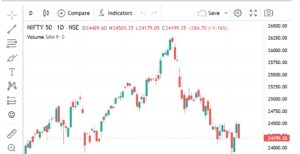Nifty and Bank Nifty Index Market Prediction: 8th November 2024

Investors and market analysts have long anticipated the movements of the Nifty 50 and Bank Nifty indices, especially as they serve as critical benchmarks for the Indian equity markets. As we look toward 8th November 2024, analyzing various technical indicators, global economic trends, and sectoral influences is essential for forming a well-informed market outlook. In this comprehensive analysis, we break down factors that could impact Nifty and Bank Nifty indices, helping investors navigate the market with an edge.
Overview of the Nifty and Bank Nifty Indices
The Nifty 50 Index, representing the top 50 stocks in the National Stock Exchange of India (NSE), serves as a barometer of the Indian economy. This index encompasses companies from multiple sectors, including technology, finance, healthcare, and consumer goods. Meanwhile, the Bank Nifty Index is more sector-focused, reflecting the performance of the 12 most prominent banking stocks listed on NSE. Given the significant weightage of banking stocks within Nifty 50, the performance of Bank Nifty is often a key determinant of the broader market’s trajectory.
Technical Analysis of Nifty and Bank Nifty for 8th November 2024
1. Nifty Index Technical Outlook
As of early November 2024, Nifty has shown mixed performance amidst global volatility and domestic economic data releases. Key technical levels and patterns are essential to monitor:
- Resistance and Support Levels:
The Nifty index is currently facing resistance around the 24,500 level, with strong support found near 23,800. A breakthrough above 24,500 could trigger bullish momentum, while a slip below 23,800 may indicate bearish sentiment. - Moving Averages:
The 50-day moving average (DMA) is trending upward, suggesting medium-term bullishness. However, the 200-day moving average (DMA) continues to lag, signaling a need for caution. The Nifty’s proximity to its 50-DMA at 24,200 offers an intermediate support level, while any cross below the 200-DMA could trigger a sell-off. - Relative Strength Index (RSI):
With the RSI hovering around 55, the Nifty is neither overbought nor oversold. This neutral RSI level suggests potential consolidation, yet a rise above 60 may hint at bullish opportunities.
2. Bank Nifty Index Technical Outlook
Banking stocks have seen high volatility, driven by macroeconomic factors and sector-specific developments. Let’s look into some of the key indicators for Bank Nifty:
- Resistance and Support Levels:
Bank Nifty is currently testing resistance at 52,000 and has established solid support around 51,500. Breaking above 52,000 could catalyze a bullish breakout, while a drop below 51,200 might initiate downward pressure. - Moving Averages:
The 50-DMA and 200-DMA for Bank Nifty are closer than usual, indicating a potential golden cross, which often signifies the beginning of an uptrend. Watch for a cross above 52,500 as a potential bullish signal in the coming sessions. - RSI and MACD Indicators:
Bank Nifty’s RSI remains around 52, which, similar to Nifty, suggests a neutral stance. The Moving Average Convergence Divergence (MACD), however, is beginning to show a bullish crossover, indicating that the momentum may shift in favor of the bulls.
Global Economic Indicators Impacting Nifty and Bank Nifty
3. Impact of US Federal Reserve Policies
The US Federal Reserve’s stance on interest rates remains a critical factor influencing global equity markets, including India. With recent indications of a pause in rate hikes, global markets, including Nifty and Bank Nifty, may witness eased volatility. Lower rates in the US could attract foreign institutional investors (FIIs) to Indian markets, providing a positive sentiment boost.
4. Crude Oil Prices and Inflationary Pressures
Fluctuations in crude oil prices heavily impact the Indian economy due to India’s dependency on oil imports. Elevated oil prices contribute to inflationary pressures, which may lead to tighter monetary policy from the Reserve Bank of India (RBI). With crude hovering near $90 a barrel, a significant rise could negatively affect sectors within Nifty and especially Bank Nifty, as banking stocks are sensitive to inflation trends.
5. Domestic Economic Data and Corporate Earnings
Recent quarterly earnings reports have shown mixed results, with tech and pharmaceutical sectors performing well, while manufacturing and consumer goods sectors lag. Strong earnings growth in the banking sector has supported Bank Nifty, and continued positive earnings could further enhance its trajectory. Key economic data releases such as CPI inflation and GDP growth rates expected in early November will also provide insight into potential market movements.
Sector-Specific Analysis: How Key Sectors May Influence Nifty and Bank Nifty
6. Technology Sector’s Role in Nifty Movements
With tech giants like TCS and Infosys carrying significant weight in the Nifty index, performance in the IT sector has a notable influence. Recent gains in tech stocks have provided stability to Nifty, supported by a stable dollar-rupee exchange rate. Continued strength in this sector could offset any downturns in other areas, maintaining an upward bias in the broader market.
7. Financial Sector and Bank Nifty’s Performance
The Banking sector remains the backbone of Bank Nifty and contributes heavily to Nifty as well. The recent focus on private banks, which have shown consistent growth and reduced non-performing assets (NPAs), strengthens the index’s outlook. However, any adverse developments in public sector banks could dampen the overall sector performance. Investors should monitor liquidity conditions and loan growth data for a clearer picture.
8. The Impact of Global Tech Trends on Indian IT Stocks
Recent advances in AI and automation have led to robust demand for tech services, benefitting large IT firms within the Nifty index. Companies that are well-positioned to leverage these trends are likely to see enhanced revenue streams, adding positive momentum to Nifty.
Trading Strategies for Nifty and Bank Nifty on 8th November 2024
9. For Conservative Investors
Conservative investors might consider buying Nifty near the support level of 23,800 with a target of 24,500. Stop-loss can be placed at 23,600. For Bank Nifty, a similar strategy could be employed, buying near 52,200 with a target of 53,000 and a stop-loss at 51,000.
10. For Aggressive Traders
Aggressive traders can look for opportunities based on intraday patterns. A break above 24,500 on Nifty could present a bullish momentum trade, while a drop below 23,800 in Bank Nifty may provide short-selling opportunities. Monitoring daily volume and volatility levels will be essential for day traders aiming to capitalize on these indices.
Long-Term Outlook: Potential Risks and Rewards
11. Key Risks
- Geopolitical Tensions: Ongoing geopolitical issues could disrupt supply chains and increase market volatility, impacting both indices.
- High Inflation: Sustained inflation levels could lead to increased interest rates, impacting the cost of capital for companies in both indices.
12. Potential Rewards
- Increased Foreign Investment: As global interest rates stabilize, foreign inflows could see an uptick, particularly benefiting large-cap companies in Nifty and banking giants in Bank Nifty.
- Improving Domestic Growth: India’s projected economic growth, supported by rising consumption and robust infrastructure development, provides a favorable environment for long-term gains.
Conclusion
Navigating the Nifty and Bank Nifty markets on 8th November 2024 requires a detailed understanding of technical trends, economic factors, and sectoral performances. With a balanced approach that considers both global influences and domestic data, investors can position themselves strategically in the Indian equity market. We recommend keeping a close eye on upcoming earnings reports, RBI policies, and global market cues to make informed investment decisions.









